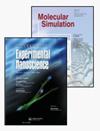Molecular dynamics investigation of the interaction between volatile organic compounds and deep eutectic solvents
IF 2
4区 化学
Q4 CHEMISTRY, PHYSICAL
引用次数: 0
Abstract
ABSTRACTMixtures of tetrabutylammonium-chloride-based deep eutectic solvent (DES) and three volatile organic compounds (VOCs) – butanal, ethanol, and toluene – have been investigated using classical molecular dynamics simulations. Various structural analyses like radial and spatial distribution functions reveal the presence of specific interactions between DES components and VOCs. The interaction between the VOC and DES components depends on the nature of the former. Both ethanol and butanal have an H-bond interaction with chloride and ethylene glycol. Tetrabutylammonium cations are present above and below the ring of toluene due to the presence of π electron cloud, and toluene also forms π hydrogen bonds with ethylene glycol. The structure of DES is not significantly affected by the absorption of VOCs, which is reflected in their radial distribution functions. Components of DES become more mobile with the addition of VOCs. The interfacial region was found to be the most favourable location for the presence of VOCs.KEYWORDS: Molecular dynamicsvolatile organic compoundsdeep eutectic solventsradial distribution functionssurface composition AcknowledgmentsThe authors gratefully acknowledge NISER – Bhubaneswar for providing the computational resources.Disclosure statementNo potential conflict of interest was reported by the author(s).挥发性有机化合物与深共晶溶剂相互作用的分子动力学研究
摘要采用经典分子动力学模拟方法研究了四丁基氯化铵深度共熔溶剂(DES)与三种挥发性有机物(VOCs)——丁醛、乙醇和甲苯的混合物。各种结构分析,如径向和空间分布函数,揭示了DES组分与VOCs之间存在特定的相互作用。VOC和DES组分之间的相互作用取决于前者的性质。乙醇和丁醛都与氯化物和乙二醇有氢键相互作用。由于π电子云的存在,四丁基铵离子存在于甲苯环的上下,甲苯也与乙二醇形成π氢键。DES的结构不受VOCs吸收的显著影响,这反映在其径向分布函数上。随着挥发性有机化合物的加入,DES的组分变得更具流动性。界面区域是最有利于挥发性有机化合物存在的区域。关键词:分子动力学;挥发性有机化合物;深共熔溶剂;径向分布函数;披露声明作者未报告潜在的利益冲突。
本文章由计算机程序翻译,如有差异,请以英文原文为准。
求助全文
约1分钟内获得全文
求助全文
来源期刊

Molecular Simulation
化学-物理:原子、分子和化学物理
CiteScore
3.80
自引率
9.50%
发文量
128
审稿时长
3.1 months
期刊介绍:
Molecular Simulation covers all aspects of research related to, or of importance to, molecular modelling and simulation.
Molecular Simulation brings together the most significant papers concerned with applications of simulation methods, and original contributions to the development of simulation methodology from biology, biochemistry, chemistry, engineering, materials science, medicine and physics.
The aim is to provide a forum in which cross fertilization between application areas, methodologies, disciplines, as well as academic and industrial researchers can take place and new developments can be encouraged.
Molecular Simulation is of interest to all researchers using or developing simulation methods based on statistical mechanics/quantum mechanics. This includes molecular dynamics (MD, AIMD), Monte Carlo, ab initio methods related to simulation, multiscale and coarse graining methods.
 求助内容:
求助内容: 应助结果提醒方式:
应助结果提醒方式:


